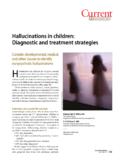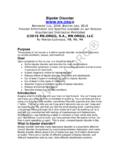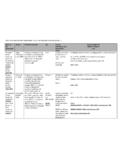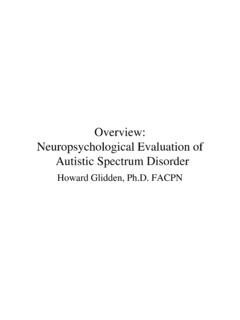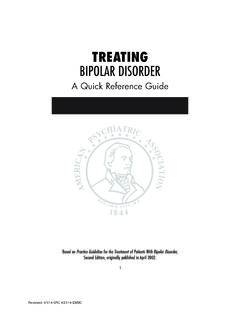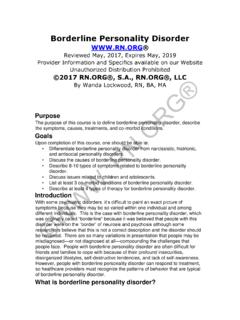Transcription of K-SADS-PL version 1 - ICCTC
1 K-SADS-PL , version , October 1996 1996, Kaufman, Birmaher, Brent, Rao All rights reservedDiagnostic InterviewKiddie-Sads-Present and Lifetime version ( K-SADS-PL ) version of October 1996 Permitted UsageThis instrument is copyrighted. Usage is freely permitted without further permission for uses which meet one or moreof the following:CClinical usage in a not-for-profit institutionCUsage in an IRB approved research protocolAll other uses require written permission of the principal author, Dr. Kaufman, including but not limited to thefollowing:CRedistribution of the instrument in printed, electronic or other formsCCommercial use of the instrumentThe latest version of the instrument, a pointer to the author s electronic mail address, and other useful information canbe found at the following WorldWide Web URL: http:\\ \ksadsK-SADS-PL, version , October 1996 1996, Kaufman, Birmaher, Brent, Rao All rights reservedVersion of 10/01/96 Diagnostic InterviewKiddie-Sads-Present and Lifetime version ( K-SADS-PL ) - Screen Interview -Child's Name: MR # Clinician: ID# Clinic.
2 Psychiatrist: Date of Interview: Month Day YearThe K-SADS-PL was adapted from the K-SADS-P (Present Episode version ), which was developed by WilliamChambers, and Joaquim Puig-Antich, , and later revised by Joaquim Puig-Antich, and Neal Ryan, The K-SADS-PL was written by Joan Kaufman, , Boris Birmaher, , David Brent, , Uma Rao, , and Neal Ryan, The K-SADS-PL was designed to obtain severity ratings of symptomatology, and assesscurrent and lifetime history of psychiatric disorders, including several disorders not surveyed in the K-SADS-P. Thecurrent instrument is greatly indebted to several other existing structured and semi-structured psychiatric instrumentsincluding the K-SADS-E (Orvaschel & Puig-Antich), the SADS-L (Spitzer and Endicott), the SCID (Spitzer, Williams,Gibbon, and First), the DIS (Robins and Helzer), the ISC (Kovacs), the DICA (Reich, Shayka, and Taibleson), and theDUSI (Tarter, Laird, Bukstein, and Kaminer).
3 Guidelines for the introductory interview at the beginning of thisinstrument were provided by Michael Rutter, and Philip Graham, , and modifications for the anxietydisorders section were provided by Cynthia Last, Other consultants include Oscar Bukstein, , Walter Kaye, , David Kolko, , Rolf Loeber, , William Pelham, , David Rosenberg, and John Walkup, Appreciation is extended to all contributors, as well as to Denise Carter-Jackson, for the word processing of thisinstrument. Sections Completed: Screen Interview #1 #2 #3 #4 #5K-SADS-PL, version , October 1996 1996, Kaufman, Birmaher, Brent, Rao All rights reservedTABLE OF CONTENTSPageIntroduction iBackground Information1 Depressive Disorders 7 Mania 12 Psychosis 14 Panic Disorder16 Separation Anxiety Disorder17 Avoidant Disorder/Social Phobia20 Agoraphobia/Specific Phobias24 Overanxious/Generalized Anxiety 25 Obsessive Compulsive Disorder 27 Enuresis 29 Encopresis 31 Anorexia Nervosa 33 Bulimia Nervosa 34 Attention Deficit Hyperactivity Disorder 36 Oppositional Defiant Disorder 38 Conduct Disorder 40 Tic Disorder42 Cigarette Use 43 Alcohol Abuse 44 Substance Abuse 46 Post-Traumatic Stress Disorder 48 Children's Global Assessment Scale 571 Diagnostic Summary Sheets 59 Drug List 61 Supplement Completion Checklist62 Shaffer, D.
4 , Gould, M., Brasic, J., Ambrosini, P., Fischer, P., Bird, H., and Aluwahlia, S. A Children's Global1 Assessment Scale (CGAS). Arch Gen Psychiatry, 1983, 40 , version , October 1996 1996, Kaufman, Birmaher, Brent, Rao All rights reservedSchedule for Affective Disorders and Schizophreniafor School Aged Children (6-18 Years)Kiddie-SADS - Lifetime version ( K-SADS-PL )The K-SADS-PL is a semi-structured diagnostic interview designed to assess current and past episodes ofpsychopathology in children and adolescents according to DSM-III-R and DSM-IV criteria. Probes and objectivecriteria are provided to rate individual symptoms. The primary diagnoses assessed with the K-SADS-PL include: MajorDepression, Dysthymia, Mania, Hypomania, Cyclothymia, Bipolar Disorders, Schizoaffective Disorders,Schizophrenia, Schizophreniform Disorder, Brief Reactive Psychosis, Panic Disorder, Agoraphobia, SeparationAnxiety Disorder, Avoidant Disorder of Childhood and Adolescence, Simple Phobia, Social Phobia, OveranxiousDisorder, Generalized Anxiety, Obsessive Compulsive Disorder, Attention Deficit Hyperactivity Disorder, ConductDisorder, Oppositional Defiant Disorder, Enuresis, Encopresis, Anorexia Nervosa, Bulimia, Transient Tic Disorder,Tourette's Disorder, Chronic Motor or Vocal Tic Disorder, Alcohol Abuse, Substance Abuse, Post-Traumatic StressDisorder, and Adjustment K-SADS-PL is a semi-structured interview.
5 The probes that are included in the instrument do not have tobe recited verbatim. Rather, they are provided to illustrate ways to elicit the information necessary to score each item. The interviewer should feel free to adjust the probes to the developmental level of the child, and use language suppliedby the parent and child when querying about specific K-SADS-PL is administered by interviewing the parent(s), the child, and finally achieving summaryratings which include all sources of information (parent, child, school, chart, and other). When administering theinstrument to pre-adolescents, conduct the parent interview first. In working with adolescents, begin with them. Whenthere are discrepancies between different sources of information, the rater will have to use his/her best clinicaljudgement. In the case of discrepancies between parents' and child's reports, the most frequent disagreements occur inthe items dealing with subjective phenomena where the parent does not know, but the child is very definite about thepresence or absence of certain symptoms.
6 This is particularly true for items like guilt, hopelessness, interrupted sleep,hallucinations, and suicidal ideation. If the disagreements relate to observable behavior ( truancy, fire setting, or acompulsive ritual), the examiner should query the parent(s) and child about the discrepant information. If thedisagreement is not resolved, it is helpful to see the parent(s) and child together to discuss the reasons for thedisagreement. Ultimately the interviewer will have to use his/her best clinical judgment in assigning the summaryratings. iiK-SADS-PL, version , October 1996 1996, Kaufman, Birmaher, Brent, Rao All rights reservedThe following guidelines should be used in coding Diagnoses: In coding current episodes (CE) of disorders, symptoms should be rated for the timeperiod when they were the most severe during the episode. Note in the margins if and when particularsymptoms ( insomnia) improved or Targeted with Medication: In coding disorders treated with medication ( ADHD), use the ratingsto describe the most intense severity of symptoms experienced prior to initiation of medication or during 'drugholidays'.
7 Note in margins symptoms targeted effectively with medication. Diagnoses: In order for an episode to be considered 'resolved' or 'past', the child should have had aminimum of two months free from the symptoms associated with the disorder. Episodes rated in the pastdisorders section should represent the most severe past (MSP) episode experienced of that given disorder. Line: For children with a history of recurrent or episodic disorders, it is recommended that a time line begenerated to chart lifetime course of disorder and facilitate scoring of symptoms associated with each episodeof the process of completing the full interview, diagnoses initially believed to be 'past' may turn out to becurrent diagnoses in partial remission. Corrections in the coding of current and past severity ratings can be made aftercompletion of the of the K-SADS-PL requires the completion of: 1) an unstructured Introductory Interview; 2) aDiagnostic Screening Interview; 3) the Supplement Completion Checklist; 4) the appropriate Diagnostic Supplements;5) the Summary Lifetime Diagnoses Checklist; and 6) the Children's Global Assessment Scale (C-GAS) ratings.
8 TheK-SADS-PL is completed with each informant separately initially, then the Summary Lifetime Diagnoses Checklist andC-GAS ratings are completed after synthesizing all the data and resolving discrepancies in informants' reports. If thereis no suggestion of current or past psychopathology, no assessments beyond the Screen Interview will be necessary. Each of the phases of the K-SADS-PL interview is discussed briefly Unstructured Introductory Interview. This section of the K-SADS-PL takes approximately 10 to 15minutes to complete. In this section, demographic, health, presenting complaint and prior psychiatric treatment data areobtained, together with information about the child's school functioning, hobbies, and peer and family relations. Discussion of these latter topics are extremely important, as they provide a context for eliciting mood symptoms(depression and irritability), and obtaining information to evaluate functional impairment. This section of the K-SADS-PL should be used to establish rapport with the parent(s) and the child, and should never be omitted.
9 Detailedguidelines for conducting the unstructured interview are contained on pages v-vi, and a scoring sheet to recordinformation obtained during this portion of the interview is included Screen Interview. The Screen Interview surveys the primary symptoms of the different diagnoses assessedin the K-SADS-PL . Specific probes and scoring criteria are provided to assess each symptom. The rater is not obligedto recite the probes verbatim, or use all the probes provided, just as many as is necessary to score each item. Probingshould be as neutral as possible, and leading questions should be avoided ( "You don't feel sad, do you?")Symptoms rated in the screen interview are surveyed for current (CE) and most severe past (MSP) episodessimultaneously. Begin by asking if the child has ever experienced the symptom. If the answer is no, rate the symptomnegative for current and past episodes and proceed to the next question. If the answer is yes, find out when thesymptom was present.
10 If the symptom is endorsed for one time frame ( currently), inquire if it was ever present atanother time ( past).The diagnoses assessed with the screen interview do not have to be surveyed in order. The interviewer maybegin inquiring about relevant diagnoses suggested by the presenting complaint information obtained during theunstructured interview. All sections of the Screen Interview must be completed, however, and most people find iteasiest to proceed from start to , version , October 1996 1996, Kaufman, Birmaher, Brent, Rao All rights reservedAfter the primary symptoms associated with each diagnosis are surveyed, skip out criteria are delineated forcurrent and past episodes of the disorder. A space is provided to indicate if the child met the skip out criteria, or if thechild has clinical manifestations of the primary symptoms associated with the specific diagnosis. If the child failed tomeet the skip out criteria for some diagnoses, the appropriate supplements should be administered after the ScreenInterview is Completion Checklist.




